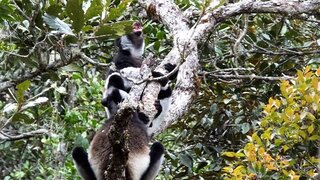Why Are the Animals All So Weird in Madagascar?
Ninety million years of isolation will do weird things to you.
DreamWorks Animation's 2005 family film Madagascar (streaming now on Peacock) begins in the big city, at the Central Park Zoo. There, a lion named Alex rules his artificial enclosure as the “King of New York,” alongside a small menagerie of friends and acquaintances. While being relocated from the zoo to a nature preserve, Alex, Melman (a giraffe), Gloria (a hippo), Marty (a zebra), and a quartet of penguins called Skipper, Kowalski, Rico, and Private fall into the ocean and wash up on Madagascar.
There, they are greeted by a wide range of bizarre creatures not found anywhere else on Earth. In the real world, Madagascar is one of the most biologically diverse places on the planet and it’s all because of its unusual geological and evolutionary history.
For More on Weird Animals:
The 10 Weirdest (Coolest) Sharks of All Time
What (Horrifying) Animals Live Near the Titanic Wreck?
How The Thing (and Other Creatures) Survive Years Frozen in Ice
Madagascar Is What Happens After 90 Million Years of Evolutionary Isolation
Madagascar is the fourth largest island in the world with an area of approximately 600,000 square kilometers, that’s roughly the same area as the state of Alaska. It lies about 300 miles southeast of the mainland African continent, close enough for some historical animal migration and far enough for those animal populations to become isolated.
It split off from the rest of Africa during the Jurassic era, about 180 million years ago, and it separated from the Indian subcontinent about 90 million years ago. It has been geographically isolated ever since. For tens of millions of years, the plants and animals of Madagascar have evolved into a uniquely isolated biosphere with a diverse array of plants and animals.
The island is home to nearly 15,000 plant species including the bizarrely structured baobab tree and an impressive lineup of weird wildlife, about 90% of which don’t exist anywhere else in the world. The most well known critter on the island is the ring-tailed lemur (that’s King Julian, to you), a species of primate related to monkeys. They are just one of more than 100 species and subspecies of lemur that call Madagascar home. In addition, there were at least 17 species of ancient lemur which are now extinct.
When humans first arrived on the island about 2,500 years ago, they found Archaeoindris, a giant lemur about the same size as a modern male gorilla. The giant lemurs lived alongside other extinct megafauna including oversized tortoises, elephant birds (the largest birds of all time), and a miniature species of hippopotamus.
The remaining lemurs share Madagascar with hundreds of species of birds and reptiles, including most of the world’s chameleons. The forest floor is populated by tomato frogs and flatid leaf bugs, both stark red in color, alongside spear-nosed snakes and leaf tailed geckos. Lemurs get most of the press on the Madagascar mammal front, but they’re not even close to the weirdest furry friends on offer.
Madagascar is home to the Fossa, a cat-like predator of indeterminate evolutionary origin. It spends its days stalking the forest chowing down on lemurs and other critters. Some of its other favorite foods include the aye-aye (a long-fingered and wide-eyed species of lemur), the foot-long giant jumping rat, capable of leaping more than 3 feet into the air, and the lowland streaked tenrec. That last Madagascar native looks like a miniature porcupine who just took a ride through the washing machine before licking an electric fence.
All of the weirdness on display in Madagascar comes down to its long-term isolation. Madagascar is a large enough island to support a robust interconnected ecosystem, and small enough for unique natural pressures to pump out plenty of evolutionary experimental forms. Its prior connection to the African and Indian continents gave it ready access to a biological hotbed, and its subsequent separation was like pinching off a pocket universe right here on Earth. There’s no place else like it.
Watch Madagascar, streaming now on Peacock.

















































